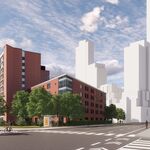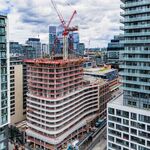M II A II R II K
Senior Member
A new kind of intersection eliminates dangerous, time-wasting left turns
Aug. 1, 2011
By Tom Vanderbilt

Read More: http://www.slate.com/articles/life/transport/2011/07/dont_turn_left.single.html
.....
Left turns are the bane of traffic engineers. Their idea of utopia runs clockwise. (UPS' routing software famously has drivers turn right whenever possible, to save money and time.) The left-turning vehicle presents not only the aforementioned safety hazard, but a coagulation in the smooth flow of traffic. It's either a car stopped in an active traffic lane, waiting to turn; or, even worse, it's cars in a dedicated left-turn lane that, when traffic is heavy enough, requires its own "dedicated signal phase," lengthening the delay for through traffic as well as cross traffic. And when traffic volumes really increase, as in the junction of two suburban arterials, multiple left-turn lanes are required, costing even more in space and money.
- What can you do when you've tinkered all you can with the traffic signals, added as many left-turn lanes as you can, rerouted as much traffic as you can, in areas that have already been built to a sprawling standard? Welcome to the world of the "unconventional intersection," where left turns are engineered out of existence. This is not necessarily a new idea: The "Jersey Jughandle" and "Michigan Left" were early iterations of this concept; rolled out widely in the 1960s, both essentially require drivers to first make a right turn, then either looping back or U-turning their way onto the road onto which they had wanted to turn left.
- "Grade separation" is the most extreme way to eliminate traffic conflicts. But it's not only aesthetically unappealing in many environments, it's expensive. There is, however, a cheaper, less disruptive approach, one that promises its own safety and efficiency gains, that has become recently popular in the United States: the diverging diamond interchange. There's just one catch: You briefly have to drive the wrong way.
- As the eastbound driver approaches the highway interchange (whose lanes run north-south), traffic lanes "criss cross" at a traffic signal. The driver will now find himself on the "left" side of the road, where he can either make an unimpeded left turn onto the highway ramp, or cross over again to the right once he has gone under the highway overpass. Perhaps counter-intuitively, this complicated approach is actually safer—and more efficient. What makes the DDI work is that it reduces the number of "conflict points" where traffic streams cross each other. There would usually be 26 such points in an intersection like this, but the DDI has only 14 (because, for example, drivers turning onto ramps no longer have to turn across oncoming traffic).
- But, as Chlewicki explained to me, not having those left-turn movements adds another advantage. In a standard "diamond" interchange, where traffic entering the highway has to turn across traffic, the two sets of traffic signals, because they have to account for the left-turn phase, are difficult to synchronize—which means cars wait in longer queues. But with the DDI, Chlewicki told me, "each signal in the interchange is only two phases, not three. And each of these two phases have some unique characteristics. The left turn from either ramp gets the same green phase as the arterial thru movement that does not conflict with that turn. It's as if the design doesn't need a separate ramp phase since it is built into the design."
.....


[video=youtube;WF9Cx0pMsbI]http://www.youtube.com/watch?v=WF9Cx0pMsbI[/video]
Aug. 1, 2011
By Tom Vanderbilt

Read More: http://www.slate.com/articles/life/transport/2011/07/dont_turn_left.single.html
.....
Left turns are the bane of traffic engineers. Their idea of utopia runs clockwise. (UPS' routing software famously has drivers turn right whenever possible, to save money and time.) The left-turning vehicle presents not only the aforementioned safety hazard, but a coagulation in the smooth flow of traffic. It's either a car stopped in an active traffic lane, waiting to turn; or, even worse, it's cars in a dedicated left-turn lane that, when traffic is heavy enough, requires its own "dedicated signal phase," lengthening the delay for through traffic as well as cross traffic. And when traffic volumes really increase, as in the junction of two suburban arterials, multiple left-turn lanes are required, costing even more in space and money.
- What can you do when you've tinkered all you can with the traffic signals, added as many left-turn lanes as you can, rerouted as much traffic as you can, in areas that have already been built to a sprawling standard? Welcome to the world of the "unconventional intersection," where left turns are engineered out of existence. This is not necessarily a new idea: The "Jersey Jughandle" and "Michigan Left" were early iterations of this concept; rolled out widely in the 1960s, both essentially require drivers to first make a right turn, then either looping back or U-turning their way onto the road onto which they had wanted to turn left.
- "Grade separation" is the most extreme way to eliminate traffic conflicts. But it's not only aesthetically unappealing in many environments, it's expensive. There is, however, a cheaper, less disruptive approach, one that promises its own safety and efficiency gains, that has become recently popular in the United States: the diverging diamond interchange. There's just one catch: You briefly have to drive the wrong way.
- As the eastbound driver approaches the highway interchange (whose lanes run north-south), traffic lanes "criss cross" at a traffic signal. The driver will now find himself on the "left" side of the road, where he can either make an unimpeded left turn onto the highway ramp, or cross over again to the right once he has gone under the highway overpass. Perhaps counter-intuitively, this complicated approach is actually safer—and more efficient. What makes the DDI work is that it reduces the number of "conflict points" where traffic streams cross each other. There would usually be 26 such points in an intersection like this, but the DDI has only 14 (because, for example, drivers turning onto ramps no longer have to turn across oncoming traffic).
- But, as Chlewicki explained to me, not having those left-turn movements adds another advantage. In a standard "diamond" interchange, where traffic entering the highway has to turn across traffic, the two sets of traffic signals, because they have to account for the left-turn phase, are difficult to synchronize—which means cars wait in longer queues. But with the DDI, Chlewicki told me, "each signal in the interchange is only two phases, not three. And each of these two phases have some unique characteristics. The left turn from either ramp gets the same green phase as the arterial thru movement that does not conflict with that turn. It's as if the design doesn't need a separate ramp phase since it is built into the design."
.....


[video=youtube;WF9Cx0pMsbI]http://www.youtube.com/watch?v=WF9Cx0pMsbI[/video]




